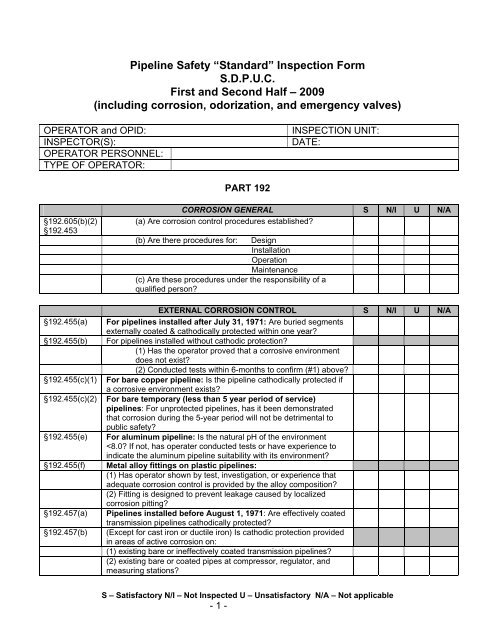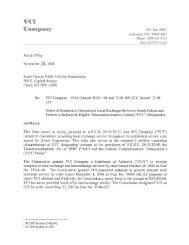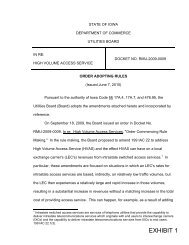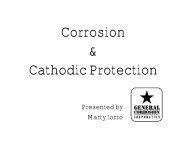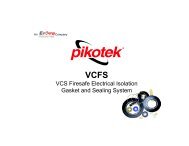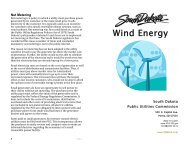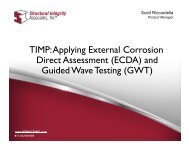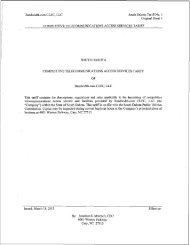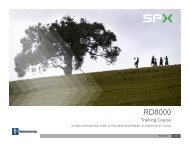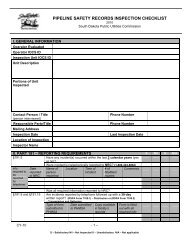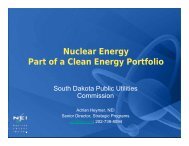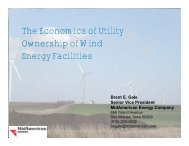Pipeline Safety Inspection Form
Pipeline Safety Inspection Form
Pipeline Safety Inspection Form
You also want an ePaper? Increase the reach of your titles
YUMPU automatically turns print PDFs into web optimized ePapers that Google loves.
<strong>Pipeline</strong> <strong>Safety</strong> “Standard” <strong>Inspection</strong> <strong>Form</strong><br />
S.D.P.U.C.<br />
First and Second Half – 2009<br />
(including corrosion, odorization, and emergency valves)<br />
OPERATOR and OPID: INSPECTION UNIT:<br />
INSPECTOR(S): DATE:<br />
OPERATOR PERSONNEL:<br />
TYPE OF OPERATOR:<br />
§192.605(b)(2)<br />
§192.453<br />
PART 192<br />
CORROSION GENERAL<br />
(a) Are corrosion control procedures established?<br />
S N/I U N/A<br />
(b) Are there procedures for: Design<br />
Installation<br />
Operation<br />
Maintenance<br />
(c) Are these procedures under the responsibility of a<br />
qualified person?<br />
EXTERNAL CORROSION CONTROL S N/I U N/A<br />
§192.455(a) For pipelines installed after July 31, 1971: Are buried segments<br />
externally coated & cathodically protected within one year?<br />
§192.455(b) For pipelines installed without cathodic protection?<br />
(1) Has the operator proved that a corrosive environment<br />
does not exist?<br />
(2) Conducted tests within 6-months to confirm (#1) above?<br />
§192.455(c)(1) For bare copper pipeline: Is the pipeline cathodically protected if<br />
a corrosive environment exists?<br />
§192.455(c)(2) For bare temporary (less than 5 year period of service)<br />
pipelines: For unprotected pipelines, has it been demonstrated<br />
that corrosion during the 5-year period will not be detrimental to<br />
public safety?<br />
§192.455(e) For aluminum pipeline: Is the natural pH of the environment<br />
EXTERNAL CORROSION CONTROL S N/I U N/A<br />
(3) existing bare or coated distribution lines?<br />
§192.459 When the operator has knowledge that any pipeline is exposed, is<br />
the exposed pipe examined for:<br />
(a) Evidence of corrosion?<br />
(b) Coating deterioration?<br />
§192.459 If external corrosion requiring remedial action is found, is the<br />
pipeline investigated circumferentially and longitudinally beyond the<br />
exposed portion to determine whether additional corrosion<br />
requiring remedial action exists?<br />
§192.459 Does operator have procedures established for examining exposed<br />
cast iron pipe for evidence of graphitization?<br />
Does operator have procedures established for remedial measures<br />
on cast iron pipe if graphitization is discovered, AGA GPTC<br />
Appendix G-18 (NTSB)?<br />
§192.461(a) Does the coating on steel pipe meet the requirements of this part?<br />
(1) applied on a properly prepared surface?<br />
(2) has sufficient adhesion to resist underfilm migration of<br />
moisture?<br />
(3) sufficiently ductile to resist cracking?<br />
(4) has sufficient strength to resist damage due to handling and soil<br />
stress?<br />
(5) compatible with supplemental cathodic protection?<br />
§192.461(b) If external coating is electrically insulating does it have low moisture<br />
absorption and high electrical resistance?<br />
§192.461(c) Is the external coating inspected prior to lowering the pipe into the<br />
ditch and is any damage repaired?<br />
§192.461(d) Is external protective coating protected from damage resulting from<br />
adverse ditch conditions or damage from supporting blocks?<br />
§192.461(e) If coated pipe is installed by boring, driving, or similar method, are<br />
precautions taken to minimize damage to the coating?<br />
§192.463 (a) Does the level of cathodic protection meet the requirements of<br />
Appendix D criteria?<br />
Appendix D Steel, cast iron, and ductile iron<br />
Part I (1) a negative (cathodic) voltage of at least 0.85 volt (Cu-CuSO4 ½<br />
cell) also need to consider IR drop<br />
(2) a negative voltage shift of at least 300 millivolts (applies to<br />
structure not in contact with metals of different anodic potentials)<br />
also need to consider IR drop<br />
(3) a minimum negative polarization voltage shift of 100 millivolts<br />
(interrupting the protective current and measuring the polarization<br />
decay)<br />
(4) voltage at least as negative as that originally established at<br />
beginning of Tafel segment of E-log-I curve<br />
(5) net protective current<br />
Refer to Appendix D if aluminum, copper, or other metals are within<br />
the system also note that other reference cells besides Cu-CuSO4<br />
half-cells can be used if they meet criteria in Section IV of Appendix<br />
§192<br />
Appendix D.<br />
Part II<br />
D<br />
Does the operator criteria consider IR drop?<br />
§192.463 (b) If amphoteric metals are included in a buried or submerged pipeline<br />
containing a metal or different anodic potential are they:<br />
S – Satisfactory N/I – Not Inspected U – Unsatisfactory N/A – Not applicable<br />
- 2 -
EXTERNAL CORROSION CONTROL S N/I U N/A<br />
(1) electrically isolated from the remainder of the pipeline and<br />
cathodically protected?; OR<br />
(2) cathodically protected at a level that meets the requirements of<br />
Appendix D for amphoteric metals?<br />
§192.463 (c) Is the amount of cathodic protection controlled to prevent damage<br />
to the protective coating or the pipe?<br />
§192.465(a) Has each pipeline that is cathodically protected been tested at least<br />
once each calendar year not to exceed 15 months?<br />
§192.465(a) Are 10 percent of short sections of mains or transmission lines and<br />
separately protected service lines distributed over the entire system<br />
tested each year on a sampling basis, with a different 10 percent<br />
checked each year, so that the entire system is checked in each 10<br />
year period?<br />
§192.465(b) Has each cathodic protection rectifier been inspected at least six<br />
times each year not to exceed 2-1/2 months?<br />
§192.465(c) Does the operator check for proper performance of each reverse<br />
current switch, diode, and interference bond whose failure would<br />
jeopardize structure protection at least six times each calendar<br />
year, but with intervals not exceeding 2-1/2 months?<br />
§192.465(c) Does the operator check for proper performance of other<br />
interference bonds at least once each calendar year, at intervals<br />
not exceeding 15 months?<br />
§192.465(d) Is prompt remedial action taken to correct any deficiencies<br />
indicated by the monitoring?<br />
(a) Shorted Casings (6 months)<br />
(b) Rectifier (2-1/2 months)<br />
(c) Low p/s readings - case by case, depends on cause<br />
§192.465(e) Does the operator have bare pipelines?<br />
(a) Are they cathodically protected?<br />
(b) Are they reevaluated at 3 year intervals not exceeding<br />
39 months?<br />
(c) Are remedial measures taken where necessary?<br />
§192.467 Are buried pipelines electrically isolated from other underground<br />
structures?<br />
(a) Are casing potentials monitored to detect the presence<br />
of shorts once each calendar year, not to exceed 15<br />
months?<br />
(b) Does the operator investigate & take appropriate action<br />
when indications of casing shorts are found?<br />
(c) Does the shorted casing procedure require or has the<br />
operator made): (Enforcement Policy)<br />
(1) Determination of a course of action to correct or<br />
negate the effects of the shorts within 6 months of<br />
discovery.<br />
(2) Verification that a short exists<br />
(3) Clearing of the short, if practicable. (This must be<br />
considered before alternative measures may be used.)<br />
(4) Filling the casing/pipe interstice with high-dielectric<br />
casing filler or other material which provides a<br />
corrosion inhibiting environment, if it is impractical to<br />
clear the short.<br />
(5) If (# 3) & (# 4) are determined to be impractical,<br />
monitor the casing with leak detection equipment for<br />
S – Satisfactory N/I – Not Inspected U – Unsatisfactory N/A – Not applicable<br />
- 3 -
EXTERNAL CORROSION CONTROL S N/I U N/A<br />
leakage at intervals not exceeding 7-1/2 months, but at<br />
least twice each calendar year.<br />
(6) If a leak is found by monitoring casings with leak<br />
detection equipment, immediate corrective action to<br />
eliminate the leak & further corrosion.<br />
(7) In lieu of other corrective actions, monitoring the<br />
condition of the carrier pipe using an internal inspection<br />
device at specified intervals.<br />
§192.467(e) (d) Are insulating devices prohibited in areas where a<br />
combustible atmosphere is anticipated unless precautions<br />
are made to prevent arcing?<br />
§192.467(f) (e) Where pipelines are located in close proximity to<br />
electrical transmission tower footings, is protection<br />
provided to the pipelines against damage due to fault<br />
currents?<br />
§192.469 Are there sufficient test stations or test points?<br />
§192.471 (a) Are test leads mechanically secure to pipe and electrically<br />
conductive?<br />
(b) Are test leads attached to minimize stress concentration on the<br />
pipe?<br />
(c) Are each bared test lead wire and bared metallic area (at point<br />
of connection) coated with an electrical insulating material<br />
compatible with the pipe coating and insulation on the wire?<br />
§192.473 (a) Does the operator monitor their system for stray currents and take<br />
appropriate steps to minimize detrimental effects?<br />
§192.473 (b) Does operator design and install each impressed current and/or<br />
galvanic anode cathodic protection system to minimize adverse<br />
effects on existing adjacent underground metallic structures?<br />
Service lines (1) Is operator cathodically protecting service lines<br />
(a) Operator owned piping/downstream of meter<br />
(b) Operator owned piping/upstream of meter<br />
(c) Customer owned piping/downstream of meter<br />
(d) Customer owned piping/upstream of meter<br />
(2) Is operator monitoring unprotected service lines<br />
(a) Operator owned piping/downstream of meter<br />
(b) Operator owned piping/upstream of meter<br />
(c) Customer owned piping/downstream of meter<br />
(d) Customer owned piping/upstream of meter<br />
(3) How is monitoring performed on unprotected<br />
services<br />
(a) Electrical Survey: Type<br />
Frequency<br />
(b) Leak Survey: Type<br />
Frequency<br />
(4) Is there a program in effect to address corrosion<br />
problems on service lines<br />
Describe:<br />
INTERNAL CORROSION CONTROL S N/I U N/A<br />
§192.475(a) Is gas tested to determine corrosive properties?<br />
§192.475(b) Whenever a pipe segment is removed from a pipeline, is it<br />
examined for evidence of internal corrosion?<br />
S – Satisfactory N/I – Not Inspected U – Unsatisfactory N/A – Not applicable<br />
- 4 -
INTERNAL CORROSION CONTROL S N/I U N/A<br />
If internal corrosion is found -<br />
§192.475(b) (1) Is the adjacent pipe must be investigated to determine<br />
the extent of internal corrosion?<br />
(2) Is replacement made to the extent required by<br />
§§192.485, 192.487, or 192.489?<br />
(3) Is remedial action taken (if required) to minimize<br />
internal corrosion?<br />
§192.475(c) IGas containing >0.25 grain of hydrogen sulfide per 100 ft3 (at<br />
standard conditions) may not be stored in pipe-type or bottle-type<br />
holders.<br />
§192.476(a) Design and construction of transmission line installed after May<br />
23, 2007:<br />
Has transmission line or replacement of line pipe, valve, fitting, or<br />
other line component in a transmission line met the following<br />
requirements (unless operator proves impracticable or<br />
unnecessary):<br />
(1) configured to reduce risk liquid collection in line<br />
(2) has effective liquid removal features if configuration would allow<br />
liquid collection<br />
(3) allow for use of devices for monitoring internal corrosion at<br />
locations with significant potential for internal corrosion<br />
§192.476(c) If operator changes configuration of transmission line, did they<br />
evaluate the impact of the change on internal corrosion risk to<br />
downstream portion of line and provide for removal of liquids and<br />
monitoring of internal corrosion?<br />
§192.476(d) Does operator maintain records that demonstrate compliance with<br />
this section? Does operator maintain as-built drawings or other<br />
construction records if found impracticable or unnecessary to follow<br />
(a)(1,2.3)<br />
§192.477 Have coupons (for corrosive gas only) been utilized & checked at<br />
least twice annually not to exceed 7-1/2 months?<br />
ATMOSPHERIC CORROSION CONTROL S N/I U N/A<br />
§192.479(a) Have above ground facilities been cleaned and coated?<br />
§192.479(b) Is the coating material suitable for the prevention of<br />
atmospheric corrosion?<br />
§192.481(a) Does the operator inspect piping exposed to the atmosphere at<br />
least once every 3 calendar years, at intervals not to exceed 39<br />
months for onshore piping?<br />
§192.481(b) During inspection does the operator give particular attention to pipe<br />
at soil-to-air interfaces, under thermal insulation, under disbanded<br />
coating, at pipe supports, at deck penetrations, and in spans over<br />
water?<br />
§192.481(c) If atmospheric corrosion is found, does the operator provide<br />
protection against the corrosion as required by §192.479?<br />
REMEDIAL MEASURES S N/I U N/A<br />
§192.483 Is replacement steel pipe coated and cathodically protected?<br />
§192.485(a) For each segment of transmission line with general corrosion and<br />
with a remaining wall thickness less than that required for the<br />
MAOP of the pipeline, is the section of pipeline replaced, repaired,<br />
or have the operating pressure reduced?<br />
S – Satisfactory N/I – Not Inspected U – Unsatisfactory N/A – Not applicable<br />
- 5 -
REMEDIAL MEASURES S N/I U N/A<br />
§192.485(b) For each segment of transmission line with localized pitting to a<br />
degree where leakage might result, is the section of pipeline<br />
replaced, repaired, or have the operating pressure reduced?<br />
§192.485(c) Strength of pipe based on actual remaining wall thickness may be<br />
determined by ASME/ANSI B31G or AGA PR 3-805<br />
§192.487(a) For distribution lines with a remaining wall thickness less than that<br />
required for the MAOP of the pipeline or a remaining wall thickness<br />
less than 30 percent of the nominal wall thickness, does the<br />
operator replace or repair the pipe?<br />
§192.487(b) For distribution lines, does the operator replace or repair pipe with<br />
localized corrosion pitting?<br />
§192.489(a) Is each segment of cast iron or ductile iron pipe on which general<br />
graphitization is found to a degree where a fracture or any leakage<br />
might result, replaced?<br />
§192.489(b) Is each segment of cast iron or ductile iron pipe on which localized<br />
graphitization is found to a degree where any leakage might result,<br />
replaced or repaired, or sealed by internal sealing methods?<br />
CORROSION CONTROL RECORDS S N/I U N/A<br />
§192.491(a) Does the operator maintain records or maps showing the location<br />
of cathodically protected pipe and facilities?<br />
§192.491(b) Does the operator retain records showing the location of<br />
cathodically protected pipe and facilities for the life of the system?<br />
(See records check list)<br />
§192.491(c) Does the operator maintain a record of each test, survey, or<br />
inspection required by this subpart in sufficient detail to<br />
demonstrate adequacy of corrosion control measures or that a<br />
corrosive condition does not exist for at least 5 years?<br />
§192.491(c) Does the operator retain records related to §§192.465(a) and (e)<br />
and 192.475(b) retained for as long as the pipeline remains in<br />
service?<br />
ODORIZATION OF GAS S N/I U N/A<br />
§192.605(b) Procedures for §192.625?<br />
§192.625(a) Chemical Properties - Brand Name –<br />
One-Fifth of<br />
the Lower<br />
Explosive<br />
Limit<br />
Odorometer (See records check list)<br />
Injection Rate<br />
Odorization Method –<br />
§192.625(b) Transmission Lines in Class 3 or 4 locations must comply with<br />
192.625(a) if 50% or less of the length of the line downstream is in<br />
a Class 1 or 2 location. There are also other exceptions found<br />
within this section<br />
§192.625(e) Does the equipment introduce the odorant without wide variations<br />
in the level of odorant?<br />
§192.625(f) Does the operator conduct periodic sampling of combustible gases<br />
using an instrument capable of determining the percentage of gas<br />
in air at which the odor becomes readily detectable?<br />
S – Satisfactory N/I – Not Inspected U – Unsatisfactory N/A – Not applicable<br />
- 6 -
ABANDONMENT OR DEACTIVATION OF FACILITIES S N/I U N/A<br />
§192.605(b) Does the O&M Plan provide for abandonment or deactivation of<br />
pipelines?<br />
§192.727(b) Is each pipeline that is abandoned in place, disconnected from all<br />
sources and supplies of gas, purged of gas, and sealed at both<br />
ends?<br />
§192.727(c) Is each inactive pipeline (except service lines) that is not being<br />
maintained, disconnected from all sources and supplies of gas,<br />
§192.727(d)<br />
(1)(2)(3)<br />
purged of gas, and sealed at both ends?<br />
When discontinuing service to a customer, does the operator lock<br />
or take other means to prevent a valve from being opened by<br />
unauthorized persons, or use other means?<br />
TAPPING PIPELINES UNDER PRESSURE S N/I U N/A<br />
§192.605(b) Procedures for §192.627?<br />
§192.627 Are hot taps made by qualified personnel? (See records check list)<br />
Qualifier: Do they Non-Destructive Test tap area?<br />
PIPELINE PURGING S N/I U N/A<br />
§192.605(b) Procedures for §192.629?<br />
§192.629 Purging of pipelines must be done to prevent entrapment of an<br />
explosive mixture in the line.<br />
§192.629(a) Are the lines which contain air properly purged with gas?<br />
§192.629(b) Are lines containing gas properly purged with air (or inert gas)?<br />
MAINTENANCE S N/I U N/A<br />
§192.605(b) Procedures for §192.703?<br />
§192.703(b) Is each segment of a pipeline that becomes unsafe, replaced,<br />
repaired or removed from service? (See records check list)<br />
§192.703(c) Are hazardous leaks repaired promptly?<br />
CAULKED BELL AND SPIGOT JOINTS S N/I U N/A<br />
§192.605(b) Procedures for §192.753?<br />
§192.753 Does the operator have cast-iron pipe with caulked bell and spigot<br />
joints that is subject to 25 p.s.i.g. or more? (See records check list)<br />
§192.753(a) Does the operator install mechanical clamps, or use a material or<br />
devices that will not reduce the flexibility of the joint, permanently<br />
bonds, and seals in a manner that meets the strength,<br />
environmental, and chemical compatibility requirements of<br />
§192.53(a) and (b) and §192.143?<br />
§192.753(b) When each cast-iron caulked bell and spigot joint subject to<br />
pressures of 25 p.s.i.g. or less is exposed, does the operator seal<br />
by a means other than caulking?<br />
PROTECTING CAST IRON PIPELINES S N/I U N/A<br />
§192.605(b) Procedures for §192.755?<br />
S – Satisfactory N/I – Not Inspected U – Unsatisfactory N/A – Not applicable<br />
- 7 -
PROTECTING CAST IRON PIPELINES S N/I U N/A<br />
§192.755 When the operator has knowledge that a segment of buried castiron<br />
pipe is disturbed, does the operator provide protection from:<br />
§192.755(a)(1) Vibrations from heavy construction equipment, trains,<br />
trucks, buses, or blasting.<br />
§192.755(a)(2) Impact forces by vehicles<br />
§192.755(a)(3) Earth movement<br />
§192.755(a)(4) Apparent future excavations near the pipeline<br />
§192.755(a)(5) Other foreseeable outside forces which might subject that<br />
segment of pipeline to a bending stress?<br />
§192.755(a)(6) As soon as feasible does the operator provide permanent<br />
protection for the disturbed section? (See records check list)<br />
CUSTOMER NOTIFICATION S N/I U N/A<br />
§192.16 Has the operator notified all customers by August 14, 1996 or new<br />
customers within 90 days of their responsibility for those sections of<br />
service lines not maintained by the operator? (See records check list)<br />
§192.16 (b) Does the operator have a current copy of the notification?<br />
Does notification contain all the following requirements:<br />
(1) operator does not maintain the customer’s buried piping<br />
(2) if customer’s buried piping is not maintained, it may be subject<br />
to corrosion and leakage<br />
(3) buried gas piping should be:<br />
(i) periodically inspected for leaks<br />
(ii) periodically inspected for corrosion (if metal pipe)<br />
(iii) repaired if any unsafe condition is discovered<br />
(4) when excavating near buried gas piping, the piping should be<br />
located in advance, and the excavation done by hand<br />
(5) the operator, plumbing contractors, and heating contractors can<br />
assist in locating, inspecting, and repairing the customer’s buried<br />
piping<br />
LINE MARKERS S N/I U N/A<br />
§192.605(b) Procedures for §192.707?<br />
§192.707(a) Are buried mains and transmission lines marked as required in the<br />
following areas:<br />
(1) at each crossing of a public road and railroad<br />
(2) wherever necessary to identify the location of the line to reduce<br />
possibility of damage or interference<br />
§192.707(b) EXCEPTIONS where line markers are NOT required:<br />
(1) lines located at crossings of or under waterways and other<br />
water bodies<br />
(2) mains in Class 3 or 4 location where damage prevention<br />
program is in effect under §192.614<br />
(3) transmission lines in Class 3 or 4 locations until 3/20/1996<br />
(4) transmission lines in Class 3 or 4 locations where placement of<br />
line marker is impractical<br />
§192.707(c) Are line markers installed on aboveground areas accessible to the<br />
public?<br />
§192.707(d) Do the line markers have the latest characteristics?<br />
(1) “Warning”, “Caution”, “Danger” followed by “Gas <strong>Pipeline</strong>” (1”<br />
high with ¼” stroke except in heavily developed areas)<br />
(2) name and telephone number of operator (24 hr access)<br />
S – Satisfactory N/I – Not Inspected U – Unsatisfactory N/A – Not applicable<br />
- 8 -
PATROLLING - DISTRIBUTION S N/I U N/A<br />
§192.605(b) Procedures for §192.721? (See records check list)<br />
§192.721(a) Frequency of patrolling mains must be determined by the severity<br />
of the conditions which could cause<br />
failure or leakage (i.e., consider cast iron, weather conditions,<br />
known slip areas, etc.)<br />
§192.721(b)(1) Does the operator patrol mains in business districts at intervals not<br />
exceeding 4-1/2 months, but at least 4 times each calendar year<br />
where anticipated physical movement or external loading could<br />
cause failure or leakage?<br />
§192.721(b)(2) Does the operator patrol mains outside business districts at<br />
intervals not exceeding 7-1/2 months, but at least 2 times each<br />
calendar year where anticipated physical movement or external<br />
loading could cause failure or leakage?<br />
PATROLLING - TRANSMISSION S N/I U N/A<br />
§192.605(b) Procedures for §192.705?<br />
§192.705(a) Does the operator patrol surface conditions for indications of leaks,<br />
construction activity, or other factors on and adjacent to line ROW?<br />
(a) Does the operator follow up on problems noted?<br />
§192.705(b) Is the maximum interval between patrols in accordance with the<br />
following: (Maximum interval between patrols of lines)<br />
Class location At Highway and Railroad<br />
Crossings<br />
At all Other Places<br />
1 and 2 2/yr (7-1/2 months) 1/Year (15 months)<br />
3 4/yr (4-1/2 months) 2/yr (7-1/2 months)<br />
4 4/yr (4-1/2 months) 4/yr (4-1/2 months)<br />
LEAKAGE SURVEYS - DISTRIBUTION S N/I U N/A<br />
§192.605(b) Procedures for §192.723?<br />
§192.723(b)(1) Does the operator conduct gas detector surveys in the business<br />
district at intervals not exceeding 15 months, but at least once each<br />
calendar year?<br />
§192.723(b)(2) Does the operator conduct leakage surveys (to include<br />
manholes/cracks in pavement/other pertinent locations) of the<br />
distribution system outside of the principal business areas at<br />
intervals not exceeding 63 months, but at least once every 5<br />
calendar year?<br />
For cathodically unprotected distribution lines subject to<br />
§192.465(e) on which electrical surveys for corrosion are<br />
impractical is a leakage survey conducted at least once every 3<br />
calendar years at intervals not exceeding 39 months?<br />
LEAKAGE SURVEYS - TRANSMISSION S N/I U N/A<br />
§192.605(b) Procedures for §192.706?<br />
§192.706 (a) Are leakage surveys of transmission lines conducted at<br />
intervals not exceeding 15 months but at least once each<br />
calendar year?<br />
S – Satisfactory N/I – Not Inspected U – Unsatisfactory N/A – Not applicable<br />
- 9 -
(b) Are lines transporting unodorized gas surveyed using<br />
leak detector equipment at intervals not exceeding 7-1/2<br />
months but at least twice each calendar year for Class 3<br />
locations and at intervals not exceeding 4-1/2 months but<br />
at least 4 times each calendar year for Class 4 locations?<br />
VALVE MAINTENANCE: DISTRIBUTION SYSTEMS S N/I U N/A<br />
§192.605(b) Procedures for §192.747?<br />
§192.747(a) Does the operator check and service each valve which might be<br />
required during an emergency at intervals not exceeding 15<br />
months, but at least once each calendar year?<br />
§192.747(b) Does the operator take prompt remedial action to correct any valve<br />
found inoperable, unless the operator designates an alternative<br />
valve?<br />
VALVE MAINTENANCE: TRANSMISSION SYSTEMS S N/I U N/A<br />
§192.605(b) Procedures for §192.745?<br />
§192.745(a) Does the operator check and service each valve which might be<br />
required during an emergency at intervals not exceeding 15<br />
months, but at least once each calendar year?<br />
§192.745(b) Does the operator take prompt remedial action to correct any valve<br />
found inoperable, unless the operator designates an alternative<br />
valve?<br />
§192.605(b) Procedures for §192.749?<br />
VAULTS S N/I U N/A<br />
§192.749(a) Is each vault that houses pressure regulating and limiting<br />
equipment (and has an internal volume of 200 ft 3 or more)<br />
inspected at least once each calendar year not exceeding 15<br />
months? (See records check list) Vaults need to be inspected to<br />
determine if they are in good physical condition and adequately<br />
vented.<br />
§192.749(b) If gas was found in vault during inspection was equipment<br />
inspected for leaks? If leaks were found were they repaired?<br />
§192.749(c) Was ventilating equipment inspected to determine if functioning<br />
properly?<br />
§192.749(d) Was vault cover inspected to assure it does not present hazard to<br />
public safety?<br />
CHANGE IN CLASS LOCATION S N/I U N/A<br />
§192.605(b) Procedures for §192.611?<br />
§192.611 What does the operator alter when population density requires a<br />
change in MAOP?<br />
(a) Test the pipe to qualify the new MAOP.<br />
(b) Reduce MAOP to meet the class location.<br />
(c) Replace pipe.<br />
Refer to 192.611 if MAOP is confirmed or revised (also see Subpart<br />
K if applicable)<br />
EXCESS FLOW VALVES S N/I U N/A<br />
§192.381(a) Are excess flow valves (that operate at > 10 psi) manufactured and<br />
S – Satisfactory N/I – Not Inspected U – Unsatisfactory N/A – Not applicable<br />
- 10 -
EXCESS FLOW VALVES<br />
tested to an industry standard or manufacturer’s written<br />
specification to ensure each valve will:<br />
S N/I U N/A<br />
§192.381(a)(1<br />
)<br />
Function properly up to the MAOP at which valve is rated;<br />
§192.381(a)(2 Function properly at all temperatures reasonably expected in the<br />
)<br />
operating environment of the service line;<br />
§192.381(a)(3 (i) at 10 psi gage – close at < 50 % above the rated closure flow<br />
)<br />
specified by manufacturer; AND<br />
§192.381(a)(3 upon closure, reduce gas flow to:<br />
)<br />
(ii)(A) no more than 5% of manufacturer’s specified closure flow<br />
rate for an EFV designed to allow pressure to equalize across the<br />
valve (up to a maximum of 20 ft 3 /hr)<br />
– OR –<br />
(ii)(B) no more than 0.4 ft 3 /hr for an EFV designed to prevent<br />
equalization of pressure across the valve; AND<br />
§192.381(a)(4 Not close when the pressure is less than the manufacturer’s<br />
)<br />
minimum specified operating pressure AND the flow rate is below<br />
the manufacturer’s minimum specified closure flow rate?<br />
§192.381(b) Do the EFV valves meet the applicable requirements of Subparts B<br />
and D?<br />
§192.381(c) Does the operator mark or otherwise identify the presence of an<br />
excess flow valve on a service line?<br />
§192.381(d) Does the operator locate the EFV as near as practical to the fitting<br />
connecting the service line to its source of gas supply?<br />
§192.381(e) Does operator not install EFV on a service line where operator has<br />
prior experience with contaminants in gas stream where<br />
contaminants could cause EFV to malfunction or where EFV would<br />
interfere with necessary O&M activities, such as blowing liquids<br />
from the line?<br />
§192.383(b) Do all eligible customers receive notification (new and replaced<br />
service lines)?<br />
§192.383(e) Does the operator have:<br />
(a) A copy of the notice currently in use<br />
(b) Evidence that the notice has been sent to customers<br />
within the previous three years.<br />
(c) Does notice contain the following information:<br />
(1) explanation that EFVs are available if customer<br />
pays cost<br />
(2) explanation of the potential safety benefits of EFVs<br />
(to include EFVs are designed to shut off gas if line<br />
breaks)<br />
(3) description of installation, maintenance, and<br />
replacement costs<br />
S – Satisfactory N/I – Not Inspected U – Unsatisfactory N/A – Not applicable<br />
- 11 -
§192.16 – Customer Notification<br />
Records Checklist<br />
(1) A copy of the notice currently in use; and<br />
(2) Evidence that the notices have been sent to customers within the previous 3 years.<br />
§192.491 – Corrosion Control Records<br />
(1) Maps showing the location of:<br />
a. Cathodically protected piping,<br />
b. Cathodic protection facilities,<br />
c. Galvanic anodes, and<br />
d. Neighboring structures bonded to the cathodic protection system.<br />
(2) Records of each test, survey, or inspection required by Subpart I:<br />
a. Exposed pipe reports (external condition),<br />
b. Pipe to soil test readings,<br />
c. Cathodic protection rectifier or other impressed current power source<br />
inspections,<br />
d. Reverse current switch, diode, and interference bond checks,<br />
e. Removed pipe report (internal condition),<br />
f. Atmospheric corrosion control monitoring.<br />
§192.625 – Odorization of Gas<br />
(1) Records of periodic sampling of gases to determine proper concentration of odorant<br />
§192.627 – Tapping <strong>Pipeline</strong>s Under Pressure<br />
(1) Names of personnel performing tap<br />
(2) Results of inspection of completed tap<br />
§192.703 – Maintenance<br />
(1) <strong>Pipeline</strong> repair records<br />
§192.709 – Transmission Line – Recordkeeping<br />
(1) Date, location, and description of each repair made to pipe<br />
§192.706 – Leakage Surveys Transmission<br />
(1) Data, location, results and description of all surveys within last 3 years<br />
S – Satisfactory N/I – Not Inspected U – Unsatisfactory N/A – Not applicable<br />
- 12 -
§192.723 – Leakage Surveys Distribution<br />
1) Data, location, results and description of all surveys within last 3 years<br />
§192.705 – Transmission Patrolling<br />
1) Data, location, results and description of all surveys within last 3 years<br />
§192.721 – Distribution Patrolling<br />
1) Data, location, results and description of all surveys within last 3 years<br />
Odorameter Calibration Records<br />
Half Cell Calibration Records<br />
S – Satisfactory N/I – Not Inspected U – Unsatisfactory N/A – Not applicable<br />
- 13 -


